
Here’s my review of the Canon PowerShot SX1 IS, Canon’s prosumer ultra-zoom camera which has a CMOS sensor, full manual controls, full HD (1080p) movie mode, 4 FPS burst mode and a whole lot of other goodies. You can also check out photos taken straight out of the camera in the Canon PowerShot SX1 IS photo gallery. What are you waiting for? Hit that link for the full review of the Canon PowerShot SX1 IS.
DPInterface Canon PowerShot SX1 IS Review
Brad Soo – March 26th, 2009 (Updated April 8th, 2009)
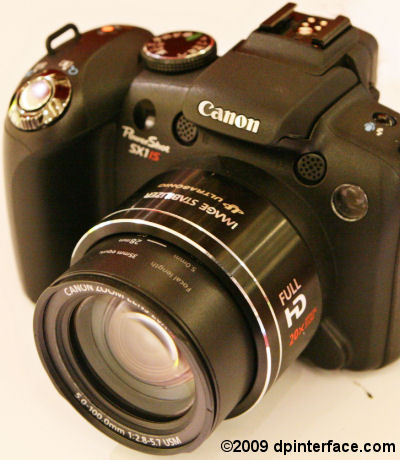
The Canon PowerShot SX1 IS precedes the old PowerShot S5 as the latest camera in Canon’s immensely popular ultra-zoom line. The upgrades here are revolutionary compared to the incremental improvements over the past few years. The PowerShot SX1 features a 10 megapixel CMOS sensor (versus CCD on traditional fixed lens cameras), a new and big 20X optical zoom lens, 2.8 inch widescreen LCD, full manual controls, RAW capabilities and a 4 FPS continuous shooting mode. Oh, the PowerShot SX1 is also the first ever fixed-lens digital camera to feature a full HD 1080p movie mode.
Is the Canon PowerShot SX1 IS the ultimate ultra-zoom camera? Find out now.
The camera also has a slightly less capable sibling (but still impressive) called the PowerShot SX10 IS, which has a more traditional 10 megapixel CCD, 2.5 inch LCD, only VGA recording and no high-speed burst mode
Size and Weight
(303.5) 127.5 x 88.3 x 87.7 mm (585 g) - Canon PowerShot SX1 IS
(299.2) 124.0 x 88.3 x 86.9 mm (560 g) – Canon PowerShot SX10 IS
(288.5) 122.6 x 81.4 x 84.5 mm (483 g) – Casio Exilim FH20
(377.4) 133.4 x 93.6 x 150.4 mm (918 g) - Fujifilm FinePix S100fs
(319.2) 123.7 x 90.5 x 105.0 mm (415 g) – Kodak EasyShare Z980
(296.0) 114.0 x 83.0 x 99.0 mm (460 g) – Nikon Coolpix P90
(297.0) 110.0 x 89.0 x 98.0 mm (435 g) – Olympus SP590UZ
(281.8) 117.6 x 75.3 x 88.9 mm (370 g) - Panasonic Lumix FZ28
(289.1) 114.5 x 82.8 x 91.8 mm (453 g) - Sony Cyber-shot HX1
All the weight figures above show when the camera is empty without a battery or memory card
The Canon PowerShot SX1 IS is larger and heavier (but not by a far margin) than most ultra-zoom cameras out there. You can sling it around your shoulder or neck, or carry it in a camera bag without feeling much of a burden compared to a digital SLR with several lenses.

Box packaging
Although I wish it came with rechargeable batteries instead, the Canon PowerShot SX1 IS comes with, an otherwise, decent bundle:
- 4 AA alkaline batteries
- Lens cap
- Lens hood
- Neck strap
- Wireless remote control
- USB and stereo A/V cables
- Camera software CD (Canon Digital Camera Solution disc)
- User’s manual
The Canon PowerShot SX1 IS doesn’t come with any memory card in the box and it has no internal memory either. Instead, you’ll have to use your own - The SX1 IS uses SD and SDHC cards, as well as MMC and its variations. MMC cards are on the slow side, so I would advise against using them on a camera like this. In terms of size, I’d recommend starting out with at least a 4 GB memory card (or even 8 or 16 GB if you’re planning to take lots of movie clips and/or RAW photos).
And in this review, I’d like to emphasize on the need to get a high-speed memory card with the camera. Not only do high-speed cards help in increasing performance, they are almost a must if you don’t want to wait forever when shooting RAW photos or using the 4 FPS burst mode (more on performance in a bit).
420 shots - Canon PowerShot SX1 IS
600 shots – Canon PowerShot SX10 IS
430 shots – Casio Exilim FH20
250 shots - Fujifilm FinePix S100fs
410 shots – Olympus SP590UZ
200 shots – Nikon Coolpix P90
460 shots - Panasonic Lumix FZ28
390 shots - Sony Cyber-shot HX1
All the cameras above are rated with rechargeable batteries according to CIPA Standard
The Canon PowerShot SX1 IS uses 4 AA batteries but comes with a set of non-rechargeable batteries. You’ll obviously need to get a set of rechargeable AA NiMH batteries which will last much longer and can be reused. With rechargeable batteries, the Canon PowerShot SX1 is rated to 420 shots per charge, which is average as far as ultra-zoom cameras go.
Accessories
In terms of accessories range, things here have shrunk since the days of the PowerShot S5 IS. The Canon PowerShot SX1 IS no longer accepts conversion lenses or filters. Perhaps one of the plausible reasons why Canon have decided to drop support for conversion lenses on the SX1 is because of the huge 20X zoom lens… that’s a mistake - I don’t think they gave any thought for those who want ultra-wide angle or insane super telephoto coverage.
However, you can still add on external flash units to the camera. The official flash units from Canon are the 270EX, 430EX II and 580EX II models. That’s wonderful news for Canon digital SLR owners since the PowerShot SX1 can share flash units from EOS cameras. You can also opt for third party flash units, but only Canon models will sync automatically with the camera. The PowerShot SX1 can also use the ST-E2 wireless flash transmitter if wireless, multiple-flash setups are your thing.
Other than that are the typical accessories you would expect from a digital camera: rechargeable AA batteries with a charger, an AC adapter and various camera cases. There’s also a HDMI cable available for the PowerShot SX1, but I believe you can get them outside for lower prices.
Camera Tour
The Canon PowerShot SX1 IS is a nicely built camera with good build quality and ergonomics. There’s a nicely sized grip for your right hand, a sturdy lens barrel where your left hand should go and none of the other parts of the camera (ie rotating screen, compartment doors) feel flimsy. The SX1 has more buttons than your typical digital camera but don’t feel intimidated, the learning curve is in fact very, very mild and there’s no clutter of controls here. My only dislike is the lack of tactile “clicks†on the rear command dial (I’m sure many of you have heard me say this before in several other compact camera reviews, and it’s an issue AGAIN here)
The PowerShot SX1 IS has full manual controls, a nice and large rotating LCD, a full HD movie mode, RAW shooting capabilities and is arguably Canon’s flagship PowerShot (yes, I know there are some people who may disagree with this; just like the time when I brought up “S5 IS vs G7, which is the flagship?†discussion two years back), or fine, perhaps tied with the G10 for that title.

The Canon PowerShot SX1 uses a new 20X optical zoom lens (up from 12X on the S5) with an aperture range of f2.8 – f5.7, and is equivalent to a 28 – 560 mm. That covers wide-angle and super telephoto at the same time and should please MOST users (but we still want conversion lenses, Canon!). There’s optical image stabilization inside the lens and also Canon’s USM drive (Ultrasonic Motor), which enables quick and quiet focusing and zooming.
Above the lens is the PowerShot SX1’s manual popup flash. The flash here is average in terms of power, and a tad weaker than the one found on the SX1’s similar-looking sibling, the PowerShot SX10 IS. At wide-angle, the flash covers a range of 50 cm to 4.8 m and that goes down to 1 to 2.6 m at telephoto (Auto ISO).
Then there are the four round circles above the lens: they are the PowerShot SX10’s stereo microphones, remote control receiver on the left and the autofocus assist/self-timer countdown lamp on the right.
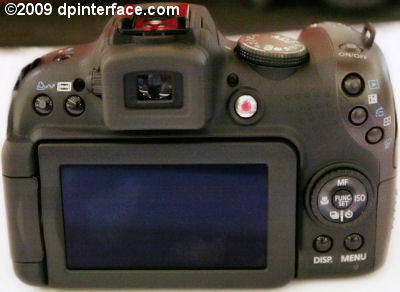
The Canon PowerShot SX1 IS features a rotating 2.8 inch widescreen LCD, up from 2.5 inches on the PowerShot S5 and SX10. You can flip it out and rotate it for self-portraits or ‘creative’ angled shots. The widescreen comes in handy when you’re taking full HD videos with the camera so the live preview doesn’t get cropped and letter-boxed. The screen’s visibility in bright light was average (you’ll want to crank up the brightness to improve things) and very good in low-light.
Directly above the LCD is the PowerShot SX1’s electronic viewfinder unit; which comes in handy when you want to steady the camera against your eye or improved visibility outdoors. The EVF has 230,000 pixels so it’s as sharp as the LCD. It also has dioptric correction, adjustable via the knob next to the viewfinder.
To the left of the EVF are two buttons. One is the print button which also serves as a shortcut button; the other button toggles aspect ratio between 4:3 and 16:9 widescreen. On the right side of the EVF is the PowerShot SX1’s dedicated movie button so you can start/stop video recording any time, regardless of mode dial position.
At the upper right corner of the PowerShot SX1 are three buttons; the upper-most button is for entering playback. The other two are for exposure compensation/playback jump and autofocus point selection/delete photo respectively. The SX1’s exposure compensation is the usual +/-2 EV in 1/3 step increments.
Next up is the Canon SX1’s five-way navigation pad with a command dial around it. The command dial is used to browse menus, change settings and scroll through photos; but I don’t like the fact that it has no tactile “clicks†at all. We’ll look at the navigation pad right now:
- Up – Manual focus
- Down – Drive mode (Single shot, continuous, continuous AF, face self-timer, self-timer, remote control)
- Left - Focus mode (Normal, macro, landscape; hold down the button for super-macro)
- Right – ISO sensitivity (Auto, high auto, 80, 100, 200, 400, 800, 1600)
- Center – Function menu/Set
The Canon PowerShot SX1 IS has a Face Self-timer mode. This works in conjunction with the camera’s face detection technology: The camera will watch the scene until an ‘extra face’ is detected, then start counting down to take up to 10 pictures in a row – it really helps so you don’t have to run to the camera the instant you press the shutter button. Of course there’s the regular 2 and 10 second countdown modes available as well as a custom timer mode which allows you to set the countdown period and number of shots the camera will take.
There’s also a very useful remote control mode, which activates the camera’s receiver so you can take pictures using the bundled wireless remote.
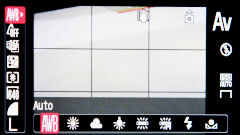
Pressing the center button brings up the camera’s function menu which contains several settings that can be changed:
- White balance (Auto, daylight, cloudy, tungsten, fluorescent, fluorescent H, flash, custom)
- My Colors (Normal, vivid, vivid red/green/blue, neutral, sepia, black & white, positive film, lighter/darker skin tone, custom)
- Bracketing (Off, exposure bracketing, focus bracketing)
- Flash exposure compensation (+/-2 EV in 1/3 step increments)/Flash power (1/3, 2/3, Full)
- Metering method (Evaluative, center-weighted, spot)
- Movie resolution
- Image size and compression
The custom option in the My Colors/Photo Effects area enables you to manually tweak contrast, saturation and sharpness up to +/- 2 in 1 step increments). The PowerShot SX1 has two bracketing modes: one is the usual exposure bracketing feature which allows you to take three shots in a row with different exposure settings. The other mode, focus bracketing is more unusual – the camera will take three photos in a row with different focus settings (one normal, one back-focused, one front-focused) in “small, medium or large†increments. There are no specific indicators of focus distance in bracketing mode.
The last two buttons we have are the DISPlay (which toggles LCD display information) and MENU buttons (to bring up the camera menu).

There are several things to cover at the top of the Canon PowerShot SX1 before we move on. On the left side is a button used for changing the flash setting; it doubles as a quick access button to voice recording in playback mode. The modes available for the built-in flash include auto, manual, flash on and flash off; with settings for redeye reduction and slow sync available in the menu.
Next to that is the camera’s built-in flash unit (pulled up manually when you want to use it) along with an external flash hotshoe. You can use any flash with the camera but only Canon ones will sync automatically with the camera. The Canon PowerShot SX1 IS can sync as fast as 1/250 sec with an external flash.
There are just three more things: the shutter button (With a zoom lever wrapped around it), power button and mode dial. The zoom controller allows the lens to move at two speeds, depending on usage pressure. A slight pull will trigger low speed zooming, pull it all the way for high-speed zoom. The shutter and power buttons are pretty self-explanatory, so I only have to go through the mode dial here:
- Custom
- Manual mode – you get full control over both shutter speed and aperture
- Aperture priority – pick an aperture value (between f2.8 to f8.0) and the camera will select a matching shutter speed
- Shutter priority – pick a shutter speed (between 1/3200 to 15 seconds) and the camera will select a matching aperture value
- Program mode – the camera will select both shutter speed and aperture; there’s Program Shift available so you can tweak the shutter/aperture combinations
- Automatic shooting
- Portrait mode
- Landscape mode
- Night scene
- Sports mode
- Other scene modes – access to other scene modes which are not on the mode dial
- Stitch assist mode – the camera brings up an interface to help you compose a panorama photo; photos need to be stitched together later on the computer
- Movie mode
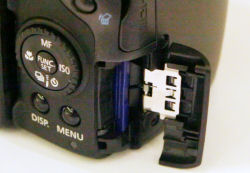
On the left side of the PowerShot SX1, there’s the speaker and nothing else (there are no more buttons on the camera’s lens barrel)…
…and on the right, this side, there’s a mini HDMI port, AC adapter port and a single mini-B port for both USB 2.0 High-speed and A/V Out connectivity. The camera’s memory card compartment is located on this side as well. The door over the compartment is of average quality and you can swap memory cards while the camera is on a tripod.
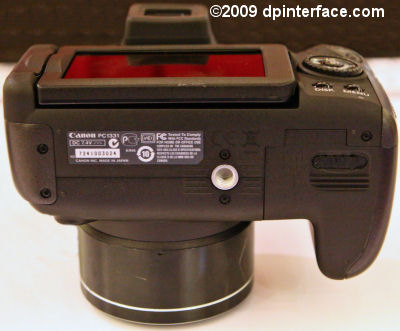
At the bottom of the Canon PowerShot SX1 IS are the camera’s metal tripod mount (which is not in-line with the lens) and battery compartment. The compartment door is quite sturdy.
Taking pictures (Shooting mode)
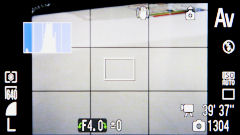
The Canon PowerShot SX1 IS tells you everything about both still shooting and movie mode on its screen; plus framing gridlines, focus point, zoom position, a live histogram and exposure settings; with the only thing missing here being a battery indicator. Thanks to the SX1’s widescreen, things are slightly less cluttered and packed together here on its display. Another great thing is that you can separately customize the type/amount of info you want to see on the LCD and the EVF respectively.
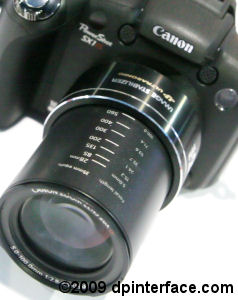
If you want something more precise than the on-screen zoom indicator, the PowerShot SX1 also has focal length markings (in 35mm terms) on its lens barrel. The markings available are 28 mm, 85 mm, 135 mm, 200 mm, 300 mm, 400 mm and 560 mm.
The 10 megapixel SX1 IS allows you to choose from multiple image sizes and compression modes to suit your needs. You can choose to use full 10 MP, 6 MP, 4 MP, 2 MP, VGA and widescreen (full res or 2 MP) and between Super Fine, Fine and Standard for compression. A 4 GB card will hold around 1,500 Fine photos at the 10 megapixel resolution
The PowerShot SX1 also features a RAW image option as well as RAW+JPEG photo (the latter option takes a RAW photo and stores a large/fine JPEG photo at the same time). RAW file sizes are much larger (13+ MB per shot) versus typical JPEG shots but you’ll get complete control over almost every single aspect of the image: white balance, noise reduction, contrast, saturation, exposure, colors, etc. If you messed up some camera settings but took the picture in RAW format, then most likely you’ll be able to correct it later on your computer. You’ll probably want a high-speed memory card here so the camera can write those huge files quicker. You can store about 260 RAW photos on a 4 GB card, or 220 RAW+JPEG photos.
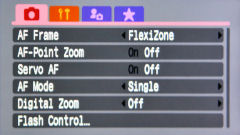
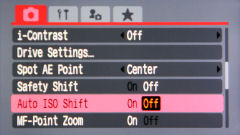
Most of the camera’s main settings can be adjusted via the Function menu I described in the previous section, but now let’s head on to the other settings in the camera’s main menu. There’s also a custom menu where you can add several items of your choice for easy accessibility.
- Autofocus mode (FlexiZone, Face detection, center AF)
- Autofocus point zoom – magnifies focus point(s) once focus is locked
- Servo autofocus – subject tracking follows a moving subject in the frame
- AF mode (Single/Continuous) – continuous AF means the camera focuses all the time, so you can take a shot quicker, but reduces battery life by a bit
- Digital zoom – you should keep this turned off, it lowers picture quality
- Flash control – adjust flash mode, flash exposure compensation, output power, sync curtain, slow sync, redeye reduction/software removal, safety FE from here
- iContrast
- Drive settings – customize self-timer delay and number of shots from here
- Spot AE point (Center/AF point) – where the spot metering point is; in the latter, the spot metering box follows the AF point around
- Safety shift – whether the camera will automatically shift settings for optimum exposure
- Auto ISO shift
- Manual focus point zoom – magnifies manual focus point for easier focusing

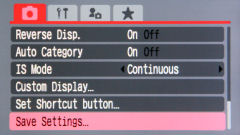
- Safety MF – allows quick shifting to optimum focus when you press the AF-point problem
- Autofocus assist beam
- Review – This option decides whether the camera will show the image on the LCD screen right after the picture is taken
- Review info (Off, normal, detailed) – amount of info shown on-screen after taking a picture
- Reverse display – toggle if the screen image is rotated along, based on rotation angle of the screen
- Auto category – the camera will sort photos into categories automatically based on scene mode
- IS Mode (Off, Continuous, Shoot-only, Panning)
- Custom display - Customize shooting info, grid lines, 3:2 guide and live histogram display for the LCD and EVF respectively
- Set shortcut button – assign a shooting function to the camera’s print button (off, metering, white balance, custom white balance, software redeye removal, digital teleconverter, iContrast, AE or AF lock, display off)
- Save settings – save custom settings to the Custom mode dial spot
The Canon PowerShot SX1 IS is able to brighten dark areas of your photos (at the cost of more noise and some extra processing time) via its iContrast feature. You can also apply iContrast after taking pictures via the playback tool.
Being a camera with full manual controls doesn’t mean the PowerShot SX1 skimps on auto and scene modes. There are plenty of scene modes here; including foliage, snow, beach, sunset, fireworks, aquarium, ISO 3200, indoor, night snapshot, color accent, color swap and long shutter.
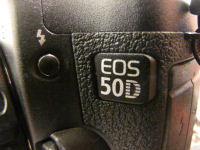
The Canon PowerShot SX1 IS features 2 macro modes. The first “normal†macro option lets you go as near as 10 to 50 cm to a subject at wide-angle. The other mode is known as Super Macro mode; which has been around since the days of the PowerShot S2 IS in 2005. Super Macro locks the lens at wide-angle but allowing you to go as close as 0 cm (no typo) to a subject. You’ll need some pretty good lighting if you want to press the lens right against your subject (the shot above was taken with the SX1’s lens almost touching the “EOS 50D†badge).
Video Recording
The Canon PowerShot SX1 IS features possibly the best movie mode in a digital camera yet. No, it’s not another “720p HD†mode… instead, Canon jumps over that, going straight to full HD 1080p recording on the SX1. The PowerShot SX1 is able to record 1080p movies (1920 x 1080) at 30 FPS with STEREO sound – that’s hard to beat. The SX1 records movies using the efficient H.264 codec, up to 4 GB per movie clip. A high-speed card is recommended here; a 4 GB card will hold around 12 minutes of full 1080p high-definition video (it eats up about 5.2 MB per second).
If you want to extend recording times, you can lower resolution to regular VGA (640 x 480) or QVGA (320 x 240) at 30 FPS. You can switch back and forth 1080p HD to normal VGA/QVGA by pressing the aspect ratio button I talked about (next to the viewfinder). No matter which setting you select, you can utilize both optical + digital zoom and optical image stabilization while recording video. The Ultrasonic Motor lens drive becomes useful here and the zoom lens operates silently. You can also play around with the microphone sensitivity level and toggle the camera’s wind filter.
I was greatly impressed by the Canon PowerShot SX1’s movie mode. High-definition clips were very clear and audio was as good as it can get. I’d like to nitpick a minor issue here though, there isn’t a 720p option here – so in case you don’t want 1080p movies guzzling your memory, you’ll have to drop down to VGA recording; there’s no in-between/slight compromise option.
Performance
All performance testing of the Canon PowerShot SX1 IS was performed using a high-speed 4 GB SanDisk Extreme III SDHC card.
The Canon PowerShot SX1 starts up very quickly in a mere 1.3 seconds. In terms of focusing speed, the camera usually focuses within 0.2 to 0.4 seconds in bright light and 0.6 to 1 second in low-light or as you approach the telephoto end of the zoom range. In low-light, the camera managed to lock focus thanks to its autofocus assist lamp. If you want better focusing in low-light, considering picking up an external flash unit (which usually come with their own built-in laser AF-assist systems).
- Shot-to-shot speed - 1 shot every 1.2 seconds, above average
- Flash recharge time using a fully charged battery - 3 seconds on average (built-in flash)
The SX1 IS has three different continuous shooting modes; all of which you can use full 10 megapixels of resolution. Continuous AF refocuses between shots and shoots at 1 frame per second while Continuous Live View (LV) shoots at a tad faster 1.2 frames per second; both shoot until the memory card fills up. The most interesting one is the SX1’s high-speed burst mode which shoots at 3.9 frames per second at full resolution without stopping (which is why I recommend using a high-speed card).
When pulling the zoom controller all the way for the lens to operate a high-speed, the lens moves from wide-angle to telephoto in just 1.5 seconds – amazing for a 20X lens! The camera’s shut down time took about 2 seconds with the lens at telephoto.
The Canon PowerShot SX1 showed some impressive performance here – from quick start up and shot-to-shot to its excellent continuous shooting mode and fast zooming speed. It may not beat a digital SLR camera for focusing speed but heck its continuous shooting surely will!
Image Quality
Let’s find out about the SX1 IS’s performance in the image quality department:







Unlike traditional fixed lens cameras which use CCD sensors, the Canon PowerShot SX1 has a 10 megapixel CMOS sensor behind its lens; which promises cleaner images out of the camera. Picture quality is good and clean, as you’d expect, at ISO 80 and 100. Noise goes up a tad at ISO 200 but the increase barely makes a difference and images are still very usable.
ISO 400 shots are still usable, but as noise goes up again at ISO 800, I’d say this (800) would be the most you’d want to use. Noise and noise reduction take over at ISO 1600 and details get washed away. At ISO 3200 (which is labeled the “ISO 3200 scene mode†in the scene position), resolution is lowered to 2 megapixels and details aren’t that clear at all.

Lens distortion was moderate while vignetting and corner softness was non-issues. I did notice some color fringing (chromatic aberration) though, which occurs at low to mild levels, more in high contrast conditions. Redeye is not an issue as the SX1 has Canon’s usual effective, multi-tier redeye removal system.
The Canon PowerShot SX1 IS produced very good quality pictures. There was low noise, no redeye and not many other issues. For those expecting noise levels dramatically lower compared to other compacts just because of the words “CMOS sensorâ€, you’ll be disappointed – no doubt noise levels are slightly lower here, the difference isn’t as large as you would imagine. The only other issue was color fringing, which you’ll have to remove using computer software. If you want more control over images and/or want to handle noise reduction yourself, there’s always the PowerShot SX1’s RAW image mode here though.
Photo gallery
Check out full-sized, unedited photos taken straight out of the camera in the Canon PowerShot SX1 IS photo gallery.
Playback

The Canon PowerShot SX1 IS has a very good playback mode. Of course, you can view your photos (complete with transition effects as you browse through them) and play videos with sound. All the basic playback functions such as print marking, slideshows, voice recording, image protection, resizing, trimming and rotation are here. You can magnify still photos by 10X and pan around using the navigation pad.
You can view the pictures you’ve taken as individual photos, in sets of nine thumbnails, by category or date. You can also manually sort photos into categories, if the camera hasn’t already done it for you. Rotating the rear command dial allows you to scroll through 3 pictures at one go. Pictures can be deleted one-by-one, by range, date, category, folder or all images.
Image Inspection mode is activated when you press the DISPlay button; which magnifies the focus point(s) in your photos so you can check if the picture is in focus. There are also three main, useful editing features here: the ability to apply iContrast to brighten photos, My Colors effects as well as a software-based redeye removal tool.
Considering the Canon PowerShot SX1 IS has a nice 1080p full HD movie mode, it’s a surprising fact that the camera lacks any “real†movie editing features besides trimming the front/end of clips.
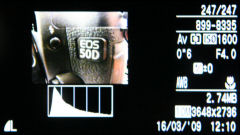
The Canon PowerShot SX1 IS shows shooting details, mode, exposure information (with shutter speed and aperture value) and a brightness histogram in playback. There’s also an overexposure alert feature which “blinks†overexposed areas of your photos to warn you about them.
Conclusion
The Canon PowerShot SX1 is a 10 megapixel ultra-zoom camera with a 20X zoom lens and optical image stabilization. The camera features a large, widescreen 2.8 inch LCD… and it rotates too so you can face it towards yourself or make good use of it to take high/low angled shots. The LCD has decent visibility under bright light and very good visibility in low-light. There’s an electronic viewfinder as well, if you prefer using that instead.
There’s a nice bundle that comes with the camera, including a lens hood and wireless remote control. One area where Canon wasn’t that thoughtful is the fact they didn’t include any rechargeable batteries or charger with the camera. The SX1 also supports external flash units, but not conversion lenses or filters (unlike the old S5).
Aside from the fact the camera’s rear command dial lacks tactile “clicks†and dedicated zoom/focus rings, the PowerShot SX1 is near flawless in other areas – there are full manual controls, a RAW mode, speedy performance and excellent 1080p movie mode. The camera has a customizable menu page, print button and mode position for storing and quickly accessing your favorite settings.
The PowerShot SX1 has a terrific 0 cm macro mode as well as good image quality. As far as CMOS sensor usage goes, there’s not a significant margin between the SX1’s image quality and other capable cameras. Perhaps pixel peepers might see a little less noise, but nevertheless, image quality is usable up till ISO 800; anything higher is still very noisy because the sensor size is still 1/2.3 inch and noise reduction smears details at those levels. So to clarify, the Canon PowerShot SX1 takes good quality photos (till ISO 800; no redeye or corner sharpness issues) but don’t expect digital SLR-like low noise levels. I also spotted some color fringing and barrel distortion in photos.
To conclude, the Canon PowerShot SX1 IS is an excellent ultra-zoom camera (one of the best out there) which is very capable in both still shooting and movie recording. The SX1 has possibly everything you could wish for: good image quality, 20X zoom, a large, rotating LCD for angled shots, full manual controls with RAW, a 4 FPS burst mode (At full resolution!!), very fast performance, full HD 1080p movie mode and the list goes on… and it definitely deserves a Highly Recommended here.
What’s hot:
- Very good image quality in general; effective redeye removal tool
- 20X optical zoom lens covers wide-angle till telephoto; has optical image stabilization
- Nice bundle in general: includes lens hood and wireless remote
- Good battery life
- Large, rotating widescreen LCD
- Full manual controls, flash hotshoe and RAW image mode
- Custom menu, button and mode position for your own settings
- Insanely close 0 cm super macro mode
- Speedy camera performance
- Excellent 4 FPS burst mode
- Full HD 1080p movie mode with stereo sound, zoom, stabilization and wind filter
What’s not:
- Some chromatic aberrations (color fringing), barrel distortion
- Command dial doesn’t have any tactile “clicksâ€; no dedicated zoom/focus rings
- Doesn’t come with rechargeable batteries; no battery indicator
- No support for conversion lenses or lens filters
Recommended Accessories:
- 4 GB or larger high-speed SDHC memory card
- Set of 4 or 8 rechargeable AA NiMH batteries and charger

Thanks Brad for the review. Now I just need to decided between the SX1 and the SX20 (I did read your review on that one also.) I guess it comes down to what I want to spend and if I need the 1080p movie mode compared to the 720p with the SX20. It would be great if Canon would of allowed you to change the setting on the SX1 to 720p. That could have decided it for me right there.
thanks again,
JonW
I just wish I could get a better feel for the image quality comparison between the SX1 and the SX20. Obviously the video is better. The lens is the same, so does the CMOS sensor improve the image quality? I would pay more for higher still image quality.
Hi Geoff, the SX1 CMOS sensor does offer an improvement over image quality of CCD cameras like the SX10 and SX20, but unfortunately, not by a far margin as many would come to expect. You can check out comparisons of SX1 vs SX10 shots in the SX10 review: http://dpinterface.com/camera-reviews/canon-powershot-sx10-review/. The image quality of the SX10 is almost identical to that of the SX20 despite the 2 MP difference between the two
By the way you can have a 52 mm filter on the lens. I have a UV filter on my PS SX1 IS